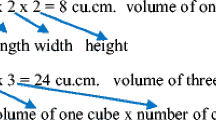Abstract
The effects of group, individual, and 2 contingencies composed of different proportions of individual and group reinforcement on cooperative behaviors were measured employing experimental and comparison children from 3 5th-grade classes. Cooperative behaviors were measured during the 25-min. periods per day in which the children worked at 40 randomly selected arithmetic problems. The four groups of Ss went through the following reinforcement conditions in a counter-balanced randomized order: 100% individual; 67% individual/33% group; 33% individual/67% group; and 100% group. The 100% group contingency consistently produced the highest incidence of cooperative behavior both wdthin and between periods. As the proportion of group reinforcement composing a contingency decreased, the incidence of cooperative behavior decreased. The results of this study suggest that group contingencies may be useful in creating cooperative work patterns in classroom settings.
Similar content being viewed by others
References
AZRIN, N. H., & LINDSLEY, O. R. 1965. The reinforcement of cooperation between children. In L. Krasner & L. P. Ullman (Eds.), Case studies in behavior modification. New York: Holt, Rinehart & Winston.
BIRNBRAUER, J. S., BIJOU, S. W., WOLF, M. M., & KIDDER, J. D. 1965. Programmed instruction in the classroom. In L. Krasner & L. P. Ullman (Eds.), Case studies in behavior modification. New York: Holt, Rinehart & Winston.
BRUNING, J. L., & KINTZ, B. L. 1968. Computational handbook of statistics. Glen-view, Ill.: Scott, Foresman.
CAMPBELL, D. T., & STANLEY, J. C. 1967. Experimental and quasi-experimental designs for research. Chicago: Rand McNally.
COHEN, D. J. 1962. Justin and his peers: An experimental analysis of a child’s social world. Child Development, 33, 697–717.
HALL, R. V., LUND, D., & JACKSON, D. 1968. Effects of teacher attention on study behavior. Journal of Applied Behavior Analysis, 1(1), 1–12.
HAMBLIN, R. L., BUCKHOLDT, D., FERRITOR, D. E., KOZLOFF, M. A., & BLACKWELL, L. J. 1971. The humanization processes. New York: Wiley.
HART, B. M., REYNOLDS, N. J., BAER, D. M., BRAWLEY, E. M., & HARRIS, F. R. 1968. Effect of contingent and non-contingent social reinforcement on the cooperative play of a preschool child. Journal of Applied Behavior Analysis, 1(1), 73–76.
HINGTGEN, J. N., SANDERS, B. J., & DEMYER, M. K. 1965. Shaping cooperative responses in early childhood schizophrenics. In L. Krasner & L. P. Ullman (Eds.), Case studies in behavior modification. New York: Holt, Rinehart & Winston.
HINGTGEN, J. N., & TROST, F. C., JR. 1966. Shaping cooperative responses in early childhood schizophrenics: II. Reinforcement of mutual physical contact and vocal responses. In R. Ulrich, T. Stachnik, & J. Mabry (Eds.), Control of human behavior. Glenview, Ill.: Scott, Foresman.
LENNES, N. J., & TRAVER, L. R. 1964. The Lennes essentials of arithmetic, 4, 5, & 6. River Forest, Ill.: Laidlaw.
LINDSLEY, O. R. 1966. Experimental analysis of cooperation and competition. In T. Verhave (Ed.), The experimental analysis of behavior-selected readings. New York: Appleton-Century-Crofts.
REYNOLDS, N. J., & RISLEY, T. R. 1968. The role of social and material rein-forcers in increasing talking of a disadvantaged preschool child. Journal of Applied Behavior Analysis, 1(3), 253–262.
STAATS, A. W., & BUTTERFIELD, W. H. 1965. Treatment of nonreading in a culturally deprived juvenile delinquent: An application of reinforcement principles. Child Development, 36, 925–942.
WIKE, E. L. 1971. A statistical primer for psychology students. New York: Aldine-Atherton.
WODARSKI, J. S., HAMBLIN, R. L., BUCKHOLDT, D. R., & FERRITOR, D. E. 1971. Effects of individual and group contingencies on arithmetic performance. Paper presented at the annual meeting of the American Educational Research Association, New York, February.
WOLF, M. M., GILES, D. K., & HALL, R. V. 1968. Experiments with token reinforcement in a remedial classroom. Behavior Research and Therapy, 6, 51–64.
Author information
Authors and Affiliations
Additional information
Portions of this manuscript were presented at the Fifth Annual Meeting, The Association for the Advancement of Behavior Therapy; Washington, D. C, September, 1971.
Rights and permissions
About this article
Cite this article
Wodarski, J.S., Hamblin, R.L., Buckholdt, D.R. et al. The Effects of Low Performance Group and Individual Contingencies on Cooperative Behaviors Exhibited by Fifth Graders. Psychol Rec 22, 359–368 (1972). https://doi.org/10.1007/BF03394100
Published:
Issue Date:
DOI: https://doi.org/10.1007/BF03394100




